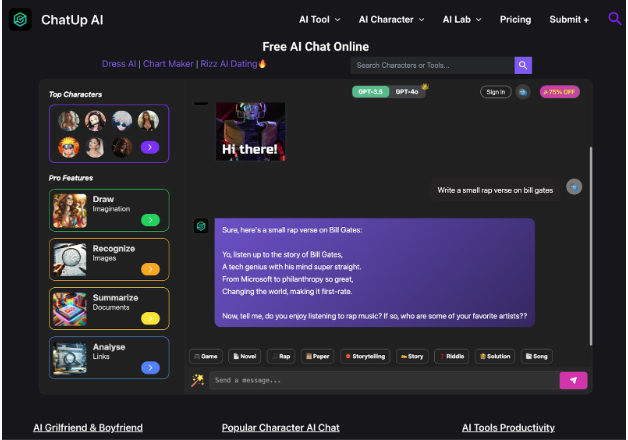AI Job Descriptions: What You Need to Know Before Applying
In today’s fast-paced digital landscape, the demand for skilled professionals in the field of artificial intelligence (AI) is skyrocketing. With the exponential growth of AI technologies across various industries, the job market is abuzz with opportunities for individuals looking to carve out a career in this cutting-edge field. However, before diving headfirst into the world of AI job applications, it’s essential to understand what these roles entail and what recruiters are looking for. Whether you’re a seasoned AI expert or a newcomer to the field, navigating through AI job descriptions can be a daunting task. Fear not, as we’re here to provide you with insights into deciphering AI job descriptions and landing your dream role. But first, let’s take a moment to explore the significance of an AI jobs description generator in streamlining the application process.
Understanding the Role of an AI Jobs Description Generator
An AI jobs description generator serves as a valuable tool for both job seekers and employers alike. By leveraging the power of artificial intelligence, these innovative platforms analyze vast amounts of data to generate comprehensive job descriptions tailored to specific roles within the AI domain. From identifying key skills and qualifications to outlining job responsibilities and expectations, an AI jobs description generator simplifies the recruitment process by providing accurate and detailed job descriptions that resonate with potential candidates. With the ability to customize job descriptions based on industry trends and organizational requirements, these tools ensure that job postings are not only informative but also appealing to top talent in the field.
Deciphering AI Job Descriptions
Now that we’ve explored the role of an AI jobs description generator, let’s delve into the intricacies of deciphering AI job descriptions manually. When browsing through job postings for AI-related roles, it’s crucial to pay close attention to the language and terminology used. While some job descriptions may be straightforward and easy to understand, others may contain technical jargon and industry-specific terms that require further clarification.
One common challenge faced by job seekers is the ambiguity surrounding certain job titles within the AI landscape. Titles such as “Machine Learning Engineer,” “Data Scientist,” and “AI Researcher” are often used interchangeably, making it difficult to discern the specific responsibilities associated with each role. Additionally, the rapid evolution of AI technologies has led to the emergence of new job titles and roles, further complicating the job search process.
This is where an AI jobs description generator can prove to be invaluable. By generating tailored job descriptions for various AI roles, these platforms provide clarity and insight into the specific skills, qualifications, and responsibilities required for each position. Whether you’re interested in machine learning, natural language processing, computer vision, or robotics, an AI jobs description generator can help you navigate through the myriad of job postings with confidence and clarity.
Key Components of AI Job Descriptions
When analyzing AI job descriptions, there are several key components to look out for:
- Job Title and Role Description: The job title should accurately reflect the role and responsibilities associated with the position. Look for keywords such as “machine learning,” “data science,” “artificial intelligence,” and “deep learning” to identify roles within the AI domain.
- Required Skills and Qualifications: Pay attention to the skills and qualifications listed in the job description. While some roles may require a strong background in mathematics, statistics, and computer science, others may prioritize experience with specific programming languages (e.g., Python, R, Java) and AI frameworks (e.g., TensorFlow, PyTorch, scikit-learn).
- Responsibilities and Expectations: Gain insight into the day-to-day responsibilities and expectations associated with the role. This may include tasks such as designing and implementing machine learning algorithms, analyzing large datasets, building predictive models, and collaborating with cross-functional teams.
- Education and Experience: Take note of the educational requirements and level of experience expected for the role. While some positions may require a bachelor’s or master’s degree in computer science, mathematics, or a related field, others may place greater emphasis on practical experience and industry certifications.
By thoroughly evaluating these components, you can gain a better understanding of what recruiters are looking for and tailor your application accordingly.
Navigating the Application Process
Armed with insights from AI job descriptions and the assistance of an AI jobs description generator, you’re now ready to navigate through the application process with confidence. Here are some tips to help you stand out:
- Customize Your Resume: Tailor your resume to highlight relevant skills, experiences, and accomplishments that align with the job description. Use keywords and phrases from the job posting to demonstrate your suitability for the role.
- Showcase Your Projects: If you have previous experience working on AI-related projects or contributing to open-source initiatives, showcase them in your portfolio or GitHub repository. This demonstrates your practical skills and passion for the field.
- Network with Peers: Attend industry events, conferences, and meetups to network with professionals in the AI community. Building connections and fostering relationships can lead to valuable career opportunities and insights.
- Prepare for Interviews: Familiarize yourself with common interview questions and be prepared to discuss your technical expertise, problem-solving abilities, and past experiences. Practice coding challenges and case studies to demonstrate your proficiency in AI concepts and methodologies.
- Stay Updated: Keep abreast of the latest developments and trends in the field of AI by following industry blogs, research papers, and online courses. Continuous learning and professional development are essential for staying competitive in the job market.
Conclusion
In conclusion, navigating through AI job descriptions can be a challenging yet rewarding endeavor. By leveraging the insights provided by AI jobs description generators and understanding the key components of job postings, you can position yourself as a strong candidate for roles within the AI domain. Remember to customize your application, showcase your skills and experiences, and stay proactive in your job search efforts. With perseverance and determination, you can land your dream job in the exciting and dynamic field of artificial intelligence.


